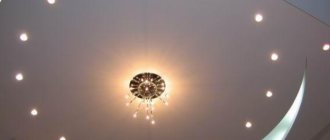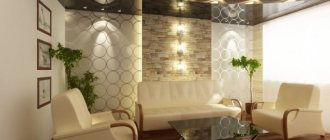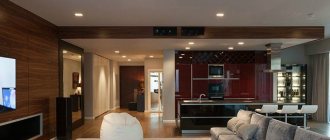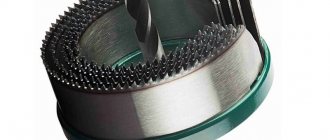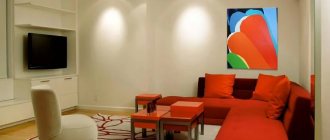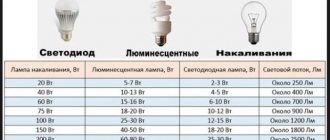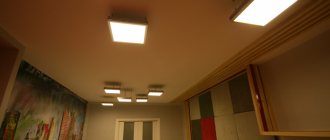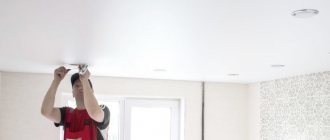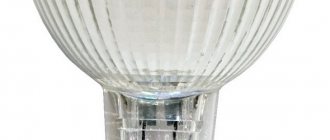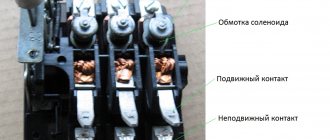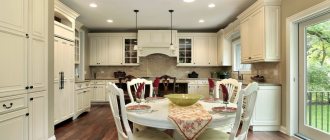Types of spotlights, their purpose for PVC ceilings and gypsum plasterboard structures. Correct installation taking into account all requirements and rules. Compliance with the distances and power of the lamps used.
To illuminate the room, lighting devices such as chandeliers, sconces, and spotlights are used. They all have their advantages, disadvantages, connection and fixation features.
Ceiling spotlights are divided into types, for which certain types of lamps are selected. They also differ in installation method. Design decisions are based on the application of these light sources for specific purposes.
Description
Spot lighting devices are used everywhere:
- in apartments for lighting the bedroom, kitchen, bath, balcony;
- in a private house or country house to illuminate not only the living space, but also the attic, cellar, garage;
- in offices, hospitals, schools, kindergartens;
- in stores and so on.
These are built-in lighting fixtures that are mounted in the ceiling (plasterboard, plastic, suspended), in the walls, on the floor. This is not only the main light, but also an additional one, which plays the role of a night light or a light source for work or homework.
Spotlights divide a large room into some areas for relaxation, work at the computer, or highlight important interior details.
Often these spots are a complement to a chandelier or floor lamps. They have different shapes like square and circle or designer decoration. They are hidden in the surface or exposed for the best lighting and to highlight a special design.
Device Features
Spots have features that distinguish them from other light sources.
- They evenly distribute light rays in a certain area of the room.
- Large selection of types, materials, colors.
- Most appliances are energy saving.
- It is possible to divide the room into areas for drinking tea and watching TV. At the same time, interior imperfections are masked.
- Easy to connect. You don't have to call an experienced electrician to do this.
The inflated cost is justified by the exclusivity of the look, energy saving, and durability.
Advantages and disadvantages
Like all lighting fixtures, spots have their pros and cons:
- The ability to focus on a specific item or a separate part of the room.
- Uniform illumination. No dark areas.
- The service life is longer than that of a conventional lighting fixture.
- Various types of lamps can be inserted into spotlights.
- Large selection in appearance.
- Energy saving.
- Resistant to mechanical damage. They don't fight.
- There is no glare, flickering or noise.
Flaws:
- There are some difficulties in designing lighting. A clear calculation is required.
- Some devices require a transformer.
- If there is a malfunction, you need to replace it with the same one.
- If many devices are built-in, they require time-consuming maintenance.
- A large room requires a large number of lamps.
Despite the disadvantages, spotlights are popular among buyers. They are installed both as additional lighting and as main lighting.
Characteristics
There are types of spots that differ in their characteristics. When choosing a lighting device, pay attention to power, size, and level of protection.
LED spots have a power of 9-18 Watts. Their color palette is cold (white) or warm (yellow). When using energy-saving lamps, you need to take into account the surface in which the lamp is mounted - tension fabric or plasterboard construction.
The degree of protection is important when the spot is chosen for wet rooms (bathroom), as well as for the attic, basement, loft, garage.
The indicators of a rotating or hinged structure are also important. This is necessary when directing light at a specific object.
Power
Spot lighting devices work with or without a transformer. If with an electricity converter, then the maximum value is 24 V. If directly from the network - 220 V.
Spots with converters are safer. They are installed in a children's room, in wet areas. And also only they are mounted in suspended ceilings, because the canvas cannot withstand high temperatures. So the maximum indicator reaches 60 V.
Dimensions
Spot devices have different sizes. Before choosing a lamp, you need to familiarize yourself with its dimensions.
- LED Lightwell LUX TM. Power 4 W, 50x57 mm.
- 60 SMD Glass Covered – 4.5 W, LED, 50x56 mm.
- COB TM - 6 WGU10 COB - LED, 50x58 mm.
- COBXTRATM— 7 W, 50x58 mm.
There are other devices that have their own sizes. Some are designed for stretch ceilings, others for gypsum plasterboard structures and plastic.
Height
Different types of lamps have different socket heights. It depends on where the lamp will be mounted. The type of socket determines which lamp is inserted. There are cartridges:
- E 27 – standard socket for incandescent lamps;
- E 14 – minions that are small in size;
- G4, G5, G9 – light bulbs with pins and small dimensions.
Depending on the ceiling covering, different lamps are used.
Features of spotlights
Any spotlight consists of the following parts: a base attached to the surface, a body on which clamps and cables are located.
Lamps for incandescent lamps are divided into two groups:
- Open, it is characterized by a U-shaped design.
- Closed, its design is based on a special casing that protects from moisture.
An incandescent lamp implies heating at high temperatures, but even despite this, the housing does not require additional protection. And all this thanks to special built-in points that are located in the lamp. They are covered with mirror amalgam, which protects the entire structure from overheating.
Spotlights also have a number of characteristics that should be taken into account when choosing them for a room:
- The light scattering angle does not exceed 30 degrees. Thus, one lamp will not be enough even for the smallest room.
- the flow of light is cone-shaped.
Spot light has its advantages, which is why it is increasingly used in modern interiors. It looks especially advantageous in a space where you need to create visual work areas.
Types of lamps
Various lamps are inserted into spotlights. They differ in power, color, size, and operating principle.
Incandescent lamps are a regular lamp. During operation, it gets very hot, so you cannot screw them into lamps on suspended ceilings; lamps with a mirror coating are used in overhead spots on wooden or plasterboard ceilings.
Luminescent - inside there is mercury and 2 electrodes. Used on stretch ceilings. They are durable, with low heat transfer. For such a lamp there should be a space of 12 cm.
Halogen – with low heat transfer, energy saving. When screwing in the lamp, you need to wear gloves.
LEDs are energy saving and do not heat up. A dimmer is required for installation. They are collected in bunches, ribbons and other groups. Shelf life is decades. The disadvantage is the cost.
Incandescent lamps
The lamp has a spiral inside the glass bulb. It has been used since ancient times. Advantages:
- low cost;
- There are different sizes;
- In some cases the heat from this lamp is needed.
Flaws:
- blind - bright;
- short shelf life;
- quickly burn out and explode during power surges;
- warming up.
The main disadvantage is low light output.
Luminescent
Lamp containing gas. They are used for the main lighting of the room. The shelf life is 20 times longer than that of an incandescent lamp. But if there are constant power surges, they quickly deteriorate. The most common is the mercury tube. Pros:
- has a large selection of colors;
- energy-saving with a large flux of light;
- does not heat up;
- life time.
Minuses:
- mercury content;
- At high temperatures, the luminous flux decreases.
- Do not work at low temperatures.
These lamps are common due to their energy savings and operating life.
LED
LEDs have many advantages. They are presented in a wide range of colors, are economical, do not heat up and provide good illumination.
Advantages:
- energy saving;
- long working life;
- environmentally friendly;
- high light output;
- there is a possibility of repair.
Flaws:
- lamps made in China are of poor quality;
- high price;
- over time they do not shine so brightly;
- use of stabilizer;
- cold colors lead to poor sleep.
Chinese lamp production has more disadvantages than advantages.
Halogen
Halogen lamps have a number of advantages:
- energy saving;
- high light output;
- long working life;
- small sizes;
- can be used in damp areas.
Flaws:
- heat;
- high price.
Halogen lamps are an alternative to fluorescent lamps.
Types of chandeliers and lamps: photos in the interior
Types of chandeliers are presented in a wide range of products, as a result of which an unknowing consumer can get confused in such a variety. If necessary, you can see how specific models look in interior design and only then make a choice.
Types of lamps by consumption
Designers recommend using energy-saving lamps and LEDs. They have a number of advantages: they last a long time, do not get hot and do not dazzle. However, these light sources cannot be used for all rooms.
If the lamp is made of durable, high-quality metal, then you can use an incandescent lamp. This would make sense in a year-round greenhouse where warmth is needed or in a basement.
220 V
Incandescent lamp. The glass bulb contains a spiral that heats up and produces bright light when current is applied.
Lamps are divided into types:
- painted, mirror, matte bulb;
- power – 25-150 W.
Matte or painted lamps are inserted into lamps in the bedroom or a separate area of the room for decoration.
The advantage is low cost, easy installation.
Disadvantage: it gets hot and breaks down quickly.
Energy saving
Halogen, fluorescent, LED light sources.
Halogen lamps are used as additional lighting for one area of a large room or as illumination of an object.
Indicators: power – 1-20 W, light output 15-22 Lm/W, operating life up to 4,000 hours.
If a halogen lamp is dirty, it will quickly fail.
Luminescent - have different shades of light. Are there any markings? in which the letter G denotes a design with pins, E – thread.
Characteristics: light output 40-80 Lm/W, power up to 80 W. Operating life up to 40,000 hours.
LED light source. It is based on a semiconductor crystal. The downside is that over time the crystal doesn't shine as brightly.
Characteristics: power up to 30 W, light output 120 Lm/W, operating life up to 50,000 hours.
The disadvantage is the high price.
Options depending on the type of room
The layout of light sources on the ceiling can be very diverse. From placing a large number of lamps around the perimeter of the room to cross-shaped LED strips, from the edges converging to the center of the ceiling.
Corridor
How to properly light a corridor:
- The basic rule is the competent use of light fluxes. In the corridor, it is best to direct the light sources towards the walls or up towards the ceiling. This will visually enlarge the room.
- When choosing lamps, it is better to choose halogen products, since it has been proven that halogen lamps help increase the height of the corridor.
- The interior design in the corridor will also be helped by increasing the width of the walls. In this case, it is best to mount the lamps on the walls - this will create a feeling of volumetric space.
Classic lighting in the corridor
Some owners of apartments or houses are content with LED strips on the ceiling in the corridor, the light of which is quite enough to move further into the room.
Kitchen
There are 2 kitchen areas: the main one (a place for cooking) and an additional one (a dining room). And if the dining room should be equipped with uniform lighting, then the place where food is prepared requires additional lighting or fairly bright light sources. Wall sconces are a good solution, but spotlights are more often used.
Basic and additional lighting in the kitchen
Bedroom
Dim or dimmable light is an ideal solution for the bedroom. In the bedroom, it is best to make 2 light sources: the main one - for good illumination of the bed and lighting as in decorative lighting. In the latter case, an LED strip hidden behind a specially mounted niche will work well. And as the main light for the bedroom, wall lamps or small neon lamps near the ceiling cornices are often used.
Many owners of apartments and houses prefer not to complicate the electrical wiring, but simply install one chandelier in the center of the room with the ability to adjust the intensity of the light flux. This device is called a dimmer.
Chandelier above the bed in the bedroom
Living room
Firstly, all types of glossy ceilings are relevant for living rooms, which reflect a directed light flux, thus spreading light throughout the entire area of the room. And for such an interior, one large chandelier with simple incandescent lamps is quite enough. But still, the picture remains a little unfinished and lighting is added around the perimeter of the ceiling.
Chandelier and spotlights in the living room
For multi-level ceilings, there is much more free space where lighting sources can be placed. The first level is the main light, made using spotlights, and the second is LED lighting, or several neon strips.
Bathroom
The bathroom does not require any special research or interesting solutions; the place near the washbasin, where the mirror most often hangs, should be illuminated, and one light source in the center of the room is sufficient. A flat chandelier with a matte shade, which will slightly muffle the light flux, is quite suitable.
Wall sconces in the bathroom
In the bathroom, much more attention should be paid to the safety of electrical wiring and all sockets and switches should be properly sealed from moisture penetration.
Balcony
Diversity in interior styles often requires converting the balcony into an additional seating area or office. Both in the first option and in the second, the balcony must have high-quality lighting, which requires the use of reliable lighting devices, which include:
- Built-in wall sconces.
- Ceiling spotlights.
- Tabletop portable light sources.
Modern design provides several options for lighting the balcony. For example, 2-3 pendant lamps on the ceiling and several wall LED light sources. The power of the light bulb is selected based on the luminous flux required for high-quality lighting of the room.
Types of mounting ceiling lights
There are different spotlights:
- Invoices. They are mounted in frameless bases and brick coverings. Consists of a housing and a mounting base. Installation is carried out in this way: the bar is fixed in the hole, and a lampshade is placed on top.
- Built-in. Space is required between the base and the ceiling. The lamp consists of a solid structure. The lampshade is fixed in the hole with claws, which straighten out from the back and hold the lamp.
- Hanging. There is a certain distance from the ceiling to the lamp. Fixation occurs on a decorative cable.
There are also:
- Rotary - when mounting them, it is necessary to strengthen the place of fixation.
- Fixed - fixation with paws.
- Swivel-and-slide – reinforcement of the base is required.
- The spots are rotating. Several devices are located on one mount.
Before purchasing, you need to familiarize yourself with the type of fastening; it may not fit the base in the apartment.
Surface-mounted lamps
For such lamps, the lampshade is attached directly to the base. Overhead models are installed directly on the ceiling plane, without the need to create niches or boxes. Due to the lack of pendants, such lamps are ideal for low ceilings.
The Vistosi Diamante surface-mounted lamp creates a spectacular play of light and shadow on the ceiling
Original Lodes Nautilus lamp with folding body
Overhead lamps use LED lamps that do not overheat. Therefore, such models are absolutely fireproof even if they fit tightly to the ceiling.
Overhead chandeliers in geometric designs are considered an absolute trend. Solid round, square or rectangular lighting structures give the interior a solid and modern look. Models made from lightweight materials (plastic, fiberglass) are suitable for installation on suspended plasterboard ceilings.
How to choose a pendant lamp
Before choosing a lighting device, you need to know in advance whether the base has a frame and whether there is space for mounting the device. And also follow the rules:
- Must be a popular manufacturer.
- Check the complete set.
- Select the correct cable with the required cross-section.
- For a built-in model, it is necessary to calculate the height of the frame.
For the kitchen they buy simple models. No patterns, relief designs. This has to do with caring for them. For suspended ceilings, round shapes are chosen.
It is also worth paying attention to the tone of the lighting, cold light or warm tone.
Cartridge design. Its dimensions determine the size and type of bulb, as well as the depth for which space is needed.
LED light sources
In addition to the usual chandelier with sockets for installing lamps, you can also purchase LED ceiling lamps. Such samples have two very significant advantages:
- LED modules are selected and integrated by manufacturers, resulting in high-quality light that can also perform specific tasks. This lighting distributes the rays evenly over all surfaces, rather than separately creating bright or dark areas.
- They don't need to be changed too often. These light sources will last for several years and do not require the purchase of new ones.
There are also several advantages of installing LED lamps instead of conventional chandeliers:
- You can save electricity five or even eight times;
- LED lamps are safe. They do not contain any substances harmful to health and do not heat up too much;
- Variety of shades. You can choose different tones from the photo of ceiling lamps from warm to cold;
- They last a long time.
Location on a suspended ceiling
For tension fabrics, there are a number of rules by which devices are installed. This is based on the fact that when heated, the canvas becomes deformed and deteriorates.
Requirements:
- Planting depth - the maximum temperature from the lamp should be 80 0C.
- The lamp should be no more than 60 W if the ceiling is fabric and no more than 40 W if it is PVC. If there is an incandescent lamp, it should be sprayed.
Diode lamps are most suitable for stretched fabrics.
- For tension fabric, only non-rotating lamps are used.
You can place devices above the level, at the same level and below the stretched fabric. The size of the mount is important: the diameters of the lamp for the canvas are 60, 65, 70, 75, 80, 85 mm. you need to carefully select the device mounts.
When choosing lighting fixtures for a ceiling with a frame base, you need to pay attention to the width, depth, length, diameter and compare it with the design of the ceiling.
Above the suspended ceiling level
The placement of lamps above the ceiling level creates harmony and comfort in the room. This is how lighting fixtures are placed in children’s rooms, where there is a pattern on the ceiling and fixtures are an addition, in bedrooms. An example is “starry sky”, recessed lamps. From them, only a light spot from the lamp is visible on the surface of the canvas.
On the same level
A common option. This is a suspended ceiling with round lamps, for example, in the kitchen, maybe in the corridor or on the balcony. The limitation is the power of the lamp used up to 35 W.
Below the suspended ceiling level
Overhead lamps. As a rule, they act not only as additional light, but also as main light. The variety of shapes, colors, and design options is great. Lamps are selected to match the interior.
How many spots are needed and how to place them
To determine the optimal number of spotlights (if you mean main lighting), there is a special formula, but the calculation can be done in a simpler way. To do this, the following calculations are carried out:
- The total number of watts per room is determined. The area of the room is multiplied by the number of Watts required by lighting standards per 1 m2. According to SNIP, the lighting level for a bedroom is 12 W/m2, for a nursery - 15 W/m2, for a living room - 20 W/m2.
- To determine the minimum number of lamps, the total number of Watts is divided by the power of the selected lamp.
You may need a lot of lamps Source legkovmeste.ru
- Inverse problem: to determine the power of one lamp, the total number of Watts is divided by the number of lamps.
Spotlights are installed taking into account the following conditions:
- The distance to the wall must be at least 70 cm.
- To determine the distance between lamps, the length of the wall is divided by the number of spots.
- To determine the distance of the lamps from the wall, half the length of the wall is divided by 2.
Placement in two rows Source pinterest.com
Installation rules
When installing a lamp, you must adhere to the following rules:
- Compliance with safety regulations. First of all, you should check if there is any electric current in the wires.
- The prepared hole must exactly match the dimensions of the lamp.
- To securely connect the wires, a crimping press is used.
- There should be identical point devices in one room.
- The distance from the wall to the light source should be no more than 60 cm, and the distance between the lamps should be 25-30 cm.
- The device is installed 30 cm from the frame components. These are fire safety rules and ease of installation.
Having taken the rules into account, installing the devices will not bring any difficulties.
Installation Requirements
When installing spots, you need to take into account the material of the stretch ceiling, the material from which the frame is made. If there is a possibility of fire, then:
- heat-resistant cables are used for wiring;
- all connections must be insulated;
- take into account the power of the lamps.
The outer layer of the wire is made of fiberglass, the inner insulation is organic rubber.
Measurements and markings
Depending on the size of the room there will be a number of lamps.
First, you need to know the height of the frame base. For halogen devices, a minimum of 60 mm is required, incandescent lamps 120 mm.
To uniformly calculate the number of devices per square meters of a room, the following conditions must be met:
- The power of each light source is no more than 35 W.
- Light beam sector 300. For uniform illumination, the beams should not intersect each other. Ceiling height 2.5 m – minimum distance between devices 1 m.
- The number of devices determines the pattern of them.
When marking, the distance from the wall to the center of the lamp should be 60 cm.
Taking into account all the specified dimensions, you can begin marking.
Hole diameter
The diameter of the hole in the ceiling must exactly match the size of the lamp. Now there are from 60 to 85 mm diameter lamps.
The hole is made with a drill with a wood bit of the required diameter.
Required materials and tools
For installation you need tools and materials:
- lamps;
- wires, switch;
- terminals or sleeves;
- insulating tape;
- pliers;
- drill with wood bit;
- meter, pencil.
With the necessary tools and materials at hand, you can begin installation.
Installation steps
Installation and connection may vary. It depends on the owner's priorities. It is possible to connect all lighting fixtures to a single-key switch. Or you can use two or three keys, then the lamps light up in groups. Based on this, a connection is made.
The ends of the cables are connected to 1 of the device sockets and grouped into a bundle. The second terminal from each cartridge is connected with a jumper, the cable from the connections leads to the bundle. The grounding is connected in the same way.
The entire bundle of cables is corrugated to a distribution box and connected to the general network.
In a bundle, the ends of the cables are connected into one phase, neutral, and ground wire. This makes a total of 3 cables. All wires are different in color - this makes it easier to find phase, neutral, and ground.
Completion of installation
The installation is completed by inserting the device body into the hole. You need to pinch the antennae, carefully insert them into the hole and release them. They will straighten out from the back and hold the lamp. Each luminaire must be checked for secure installation. After this, insert the lamps and apply electric current.
There are many types of spotlights. They differ not only in appearance, but also in the built-in lamps, in the type of rotation; some types are used for suspended ceilings, and others for gypsum plasterboard structures. When installing devices, you should take into account generally accepted rules, distances from walls and between lamps.
What types of chandeliers are there?
On sale you can find a large number of devices for artificial lighting of the room. As you know, chandeliers can be of different shapes, sizes, styles, colors; they can also differ in the installation method and the number of built-in lamps.
If we consider depending on the system, we can distinguish suspended and ceiling models. The first option must be attached to the surface using a special hook on a chain or string.
Ceiling models are great for rooms with small ceilings. Such chandeliers have the shape of a plate. Models can have a large number of segments or act as a single structure.
Important! Lampshades can be made of glass, plastic, crystal.
Choice for the street
In a terrace, gazebo or veranda, you can install a pendant model of a lighting fixture on the ceiling. This way it will be much more convenient to illuminate the tables.
Built-in or overhead light sources can be installed on a closed area, arches or facades. Their selection depends on the design of the room.
If the lighting device needs to be installed in an open area, then you should choose one that is protected from temperature changes, rust, dust and has a durable casing.
Choice for ceiling
For concrete, you can use absolutely any light sources. But it’s worth putting fire-hazardous light sources on wooden ceilings.
Overhead or hanging ones are best. If you want to take a built-in lighting device, then it is better to buy an LED one. It doesn't get too hot.
- Many people have a problem with calculating the number of lighting fixtures.
- To do this, many important factors should be taken into account such as the size of the room, the colors of the floor and walls, the function of the room, the dispersion of the rays and their power.
It is best to order professionals for this matter. How to place them? This is also not an easy task. It is necessary to take into account both the interior and the shape of the rooms.
